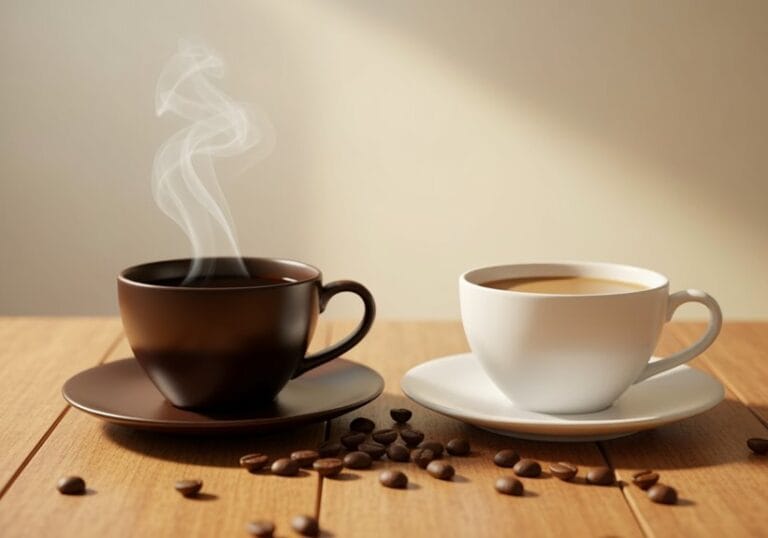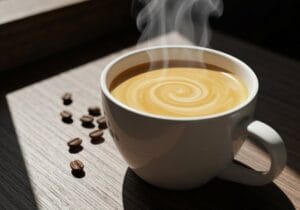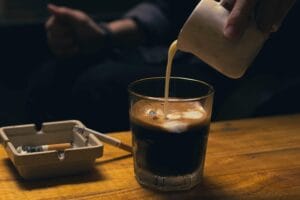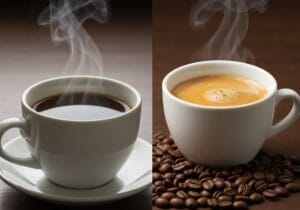So, here’s the scoop: dark roast coffee doesn’t have more caffeine than light roast! I know, right? It sounds crazy, but when you weigh them out, they pack nearly the same caffeine punch! It’s like thinking the big guy at the gym lifts more just because he’s, well, bigger. Turns out, roast level isn’t the only player here—grind size and brewing methods matter too! Stick around, there’s more coffee magic to uncover!
Key Takeaways
- Caffeine levels in light and dark roasts are nearly equal when weighed, despite roast shade differences.
- Bean type significantly affects caffeine content, making it more crucial than roast level.
- Blonde roasts generally contain more caffeine per scoop due to their density compared to darker roasts.
- Roasting results in weight loss, yet most caffeine remains stable during the roasting process.
- Brewing methods impact caffeine extraction more than the roast level itself, influencing the final caffeine content in the cup.
Understanding Caffeine Content by Roast Level
In regard to understanding caffeine content by roast level, you might think it’s all black and white, but oh boy, are you in for a surprise! It’s like thinking pizza comes without toppings—who would do that?
Well, here’s the skinny: caffeine levels in light and dark roasts are nearly equal when weighed! However, caffeine content remains consistent through roasting stages, making the roast shade a misleading focus. Interestingly, the bean type you choose can significantly influence the caffeine levels as well. Furthermore, due to their higher density, blonde roasts have more caffeine per scoop compared to dark roasts, which may be surprising.
Caffeine content in light and dark roasts? Almost identical when you weigh them!
But if you’re scooping, light roast packs a bit more punch—thanks to its denser beans.
Curiously, while we often chase that caffeine buzz for its health benefits, the flavor profile varies wildly, so you might be choosing your brew like a lost toddler in a candy store!
Keep in mind, though, brewing techniques can make a bigger difference than roast alone.
Effects of Roasting on Caffeine
When someone casually tosses out the notion that roasting coffee beans doesn’t mess with caffeine content, it’s enough to make any self-respecting coffee lover raise an eyebrow! Sure, caffeine stability is a thing, but let’s explore those roasting temperatures. Here’s the scoop: while caffeine does lose a bit during roasting (mostly from vaporizing, how rude!), it mostly stays intact. Crazy, right?
| Roast Type | Weight Loss | Caffeine Content |
|---|---|---|
| Green Beans | 0% | ~12g |
| Light Roast | 15-25% | ~12g |
| Dark Roast | 25% | ~12g |
Brewing Method and Caffeine Extraction

Brewing coffee can feel like an intricate dance, where every step—especially those involving temperature, time, and grind size—plays a critical role in the final caffeinated masterpiece!
Brews can vary wildly, and these factors can lead to a rollercoaster ride of caffeine extraction.
- Hotter temps mean quicker extraction, but too much heat? (Gasp! Say goodbye to flavor! Additionally, the caffeine concentration can change drastically if not brewed correctly.)
- Brew longer, and you might just get that jolt you crave—unless it turns bitter!
- Finer grind? Sure, but don’t forget, that can clog up your machine—yikes!
- Cold brew might take ages, but it’s like a slow-cooked stew of caffeine goodness!
- No pressure? Well, you might miss out on that espresso zap!
Each brewing method‘s effectiveness is also influenced by grind size consistency, making it essential to find the right balance!
Every brewing method has its quirks, so choose wisely!
Frequently Asked Questions
Can I Get More Caffeine From Espresso Compared to Drip Coffee?
Espresso contains considerably higher caffeine concentration per ounce than drip coffee due to its brewing methods. Although total caffeine in a standard serving can be similar, espresso provides a more potent caffeine experience in smaller volumes.
Does the Brewing Time Affect Caffeine Extraction?
Brewing time greatly influences caffeine extraction. Different brewing techniques and extraction methods enhance caffeine yield, with longer durations improving dissolution rates. Balancing time and method is essential to optimize caffeine without compromising flavor quality.
Do Decaffeinated Coffees Contain Any Caffeine?
Decaffeinated coffees do contain caffeine, retaining approximately 2 to 4 mg per cup due to historical decaf methods and caffeine extraction processes. Different decaffeination techniques impact the residual caffeine levels in the final product.
How Does Caffeine Content Vary Between Coffee Brands?
Caffeine content varies greatly among coffee brands due to factors like bean origin, roasting methods, and brewing techniques. Each brand’s unique approach results in distinct caffeine variations, influencing consumer experience and perceptions of strength.
Is Cold Brew Coffee Higher in Caffeine Than Hot Brew?
Cold brew coffee is not necessarily higher in caffeine than hot brew. The cold brew process involves slower caffeine extraction, which often results in similar caffeine levels when compared by serving size and preparation methods.
References
- https://www.healthline.com/nutrition/light-vs-dark-roast-coffee
- https://bellwoodcoffee.com/blogs/roaster-notes/light-v-dark-caffeine-content-in-coffee-roasts
- https://valor.coffee/blog/does-light-roast-coffee-really-have-more-caffeine-than-dark-roast
- https://pmc.ncbi.nlm.nih.gov/articles/PMC8228209/
- https://yorkemporium.co.uk/blogs/explore/does-the-darkness-of-coffee-roast-affect-caffeine





